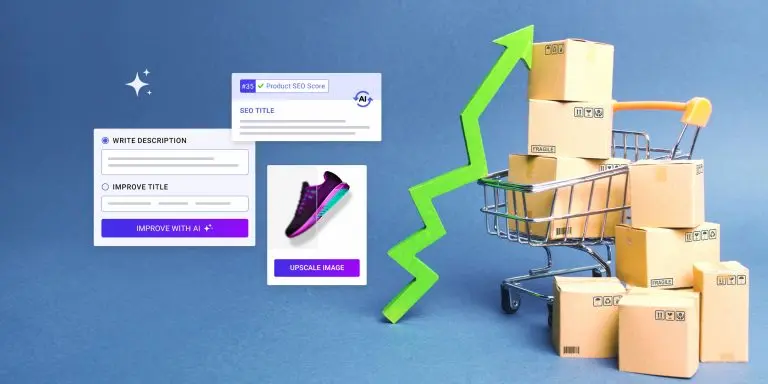Dreaming of starting a dropshipping business? You’re not alone. The competition is fierce as the allure of setting up shop online, with no need to handle inventory or large upfront costs, is quite big.
But the million-dollar question (perhaps quite literally!) remains: what can you actually expect to earn from a dropshipping website?
Below we’ll explain the complexities of dropshipping income and set some realistic expectations.
Table of Contents
Understanding the world of dropshipping
Dropshipping is often seen as a golden ticket to financial freedom. The concept is simple: you set up an online store, customers place orders, and a third party ships the products directly to them.
No muss, no fuss, right? But before you dive headfirst into this seemingly calm sea, it’s essential to understand the depth of the waters.
Behind the profits: what’s the average?
Here’s where things get interesting—or complex, depending on how you look at it. Dropshipping profits can vary widely. A typical dropshipping website might earn anywhere from a few hundred dollars to several thousand per month and even make 6 figures per year.
Now, in this article, we will be talking about how much an average dropshipping store can make. This is a store that has been on the market for more than 6 months and has daily sales of a few thousand dollars. Also, it has a profit margin of 15% and 40% daily.
So, if this is your first online store and you’re a newbie in dropshipping, then go check out this article as there we talk more in-depth about the profits dropshipping beginners can make.
Now, this is the right article if you want to know more about the average profit for a dropshipping store, then read on as we explain how much you can make dropshipping and what factors can influence your profits.
So, why these huge differences in income? Well, the income can vary due to several factors, such as:
– Niche selection and product type: Are you selling low-ticket or high-ticket products? Dropshipping pet products or high-tech gadgets? The demand and the price range in your chosen niche will influence your potential profits.
– Marketing skills: How good are you at getting your products in front of the right audience? Effective marketing can make or break your dropshipping business.
– Operational efficiency: From website speed to customer service, operational aspects play a significant role in how much you earn.
We will talk more about each of them below.
The truth behind dropshipping expenses
While talking about earnings, it’s equally crucial to discuss expenses. Running a dropshipping business isn’t entirely free. There are costs associated with marketing, platform fees, transaction fees, and sometimes even storage fees for returns or inventory management services.
Platform fees
If you’re using Shopify, WooCommerce, or any other ecommerce platform, there will be monthly fees. Additionally, payment gateways like PayPal or Stripe charge transaction fees on each sale. Also, you will need to use a dropshipping platform like AppScenic to look for products and sell them in your store. This also comes with a fee per month.
Marketing expenses
Marketing is what drives your sales, and you will need to spend on:
– Pay-per-click (PPC) advertising: Google Ads, Facebook Ads, Instagram promotions, etc.
– Email marketing tools: Services like MailChimp or Klaviyo come with subscription fees.
– SEO services: If you’re outsourcing SEO work, that’s an additional expense.
– Content creation: Paying for high-quality product photos, videos, or blog content.
These expenses can quickly add up, but they’re necessary investments for driving traffic to your store and converting visitors into customers and generating revenue.
Other costs
Other expenses you might need to have in mind can include:
– Apps and plugins: Tools to optimize your store, like review apps or inventory management tools, often come with a cost.
– Returns management: Handling returns can sometimes mean storage or processing fees.
– Customer service: If you outsource customer service, that’s another expense to consider.
Read more: The True Cost of Dropshipping – What Nobody Tells You
Profit margins are the real indicator of success
Yes, gross revenue is important, but the net profit is what truly matters. Profit margins in dropshipping can vary widely, as we already said, typically ranging from 15% to 40%.
Here are the most important factors that can influence your profit.

Factors that can influence your dropshipping profit
Now, let’s break down some specific factors that can influence how much you can make in the dropshipping world.
Product pricing range
Your product pricing range plays a significant role in your overall profitability. Selling high-ticket items (like an expensive chandelier or an electric fireplace) can mean higher profits per sale but may result in fewer overall sales.
On the other hand, selling low-cost items (like reusable water bottles) might lead to higher sales volume but lower profit margins.
Read more: How to start a high-ticket dropshipping business
Work with reliable suppliers
Finding reliable suppliers who offer competitive pricing and consistent product quality is crucial. Strong supplier relationships can lead to better deals and quicker shipping times, enhancing customer satisfaction and boosting your store’s reputation.
Customer retention
Returning customers is the goal and your brand is only as good as your last customer’s experience. Unresponsive customer service can lead to negative reviews, chargebacks, and a bad reputation. So, start implementing loyalty programs, offer exceptional customer service, and keep in touch through email marketing. All these can turn one-time buyers into repeat customers, significantly increasing your earnings over time.
Return rate
In certain niches, like clothing and shoes, the likelihood of experiencing high return rates is significant. This can substantially impact your income. While high sales volumes might appear promising, a return rate of 20-30% at the end of the month can significantly lower your overall profit. To avoid this, ensure your products are premium, unique, and of great quality. Alternatively, consider niches with lower return rates, such as high-ticket electronics or furniture.
Upselling options
Implementing upselling strategies can significantly increase your average order value by 20-30%. By convincing your existing customers to make additional purchases, you can boost your revenue. For instance, if you sell a chandelier, you can recommend a complementary lamp. So, make sure you showcase related items below your products so customers can easily see and consider them.
Sales fees
Selling on your own store typically involves paying fees to your payment gateway and ecommerce platform like Shopify. However, if you choose to sell on marketplaces like Walmart or Amazon, be prepared to pay an additional 10-20% fee. These sales fees can eat into your profit margins, so it’s important to account for them in your pricing strategy.

Can an average dropshipping store make 6 figures per year?
Yes, nowadays, an average dropshipping store can easily make 6 figures per year. To make $300,000/year, you will need $25,000/month which means an average of $833 daily. Even a newbie can make that amount but only if they choose the right niche and go for high-ticket products. Plus your products have to be of great quality, your marketing strategy on point, and your customer service must be excellent.
Let’s say you decide to start a dropshipping site selling premium eco-friendly products. Initially, your orders might only add a modest sum to your monthly income. However, as your marketing strategies begin to find their audience—perhaps through savvy social media campaigns or unbeatable email marketing—your revenue starts to grow.
So, in one month, you might pull in just a few hundred dollars. But as you refine your ads and enhance your product listings, that figure could climb to a couple of thousand. Exciting, right? It’s all part of the dropshipping journey.
Real dropshipping examples
To give you some more concrete ideas, let’s look at some examples.
Success story: the high-end home store
Jane started her dropshipping store focusing on high-end home furniture and accessories. She started dropshipping outdoor saunas priced at $5000 each. She added a modest 10% profit margin, and seld 10 units a month which meant she made a $5000 net profit/monthly.
To do that, she invested heavily in influencer marketing and high-quality content creation. Within six months, her store was generating $15,000 in monthly revenue with a 10% profit margin. Her keen understanding of her target audience and effective marketing strategies played a huge role in her success.
Learning curve: the general store
Mike launched a general store with a wide variety of products, mostly low-ticket items. Initially, he struggled to gain traction because his marketing was too broad, and he didn’t have a clear target audience. Plus he sold lower-priced items at $30 each with a profit of $10 per item, which meant he’d need to sell 500 items to make the same amount of profit as Jane did.
After a few months of mediocre sales, he decided to niche down and focus on premium pet accessories from suppliers close to his customers. This means fast shipping and low return rates. With targeted marketing and better audience engagement, his sales improved, reaching $5,000 per month with a 15% profit margin.
Profitability depends heavily on the type of products you choose and your target niche.
What’s the secret behind earning the big bucks
To edge toward the higher end of the average earnings, successful dropshippers often share a few traits:
- They are relentless learners. Staying updated on the best SEO practices and the latest in social media marketing isn’t just useful—it’s crucial.
- They understand their audience deeply. This means knowing not just what customers are buying, but why they’re buying.
- They automate and delegate. Maximizing efficiency by using tools for tasks like order processing and employing virtual assistants for customer service can scale operations and boost income.
Is dropshipping still profitable in 2024?
Absolutely! But keep in mind what we just explained and on top of these, dropshipping requires hard work, continuous learning, and adaptability. The days of quick setup and instant profit are over, given the increased competition and higher advertising costs.
However, with the right approach, many dropshippers have achieved five, six, and even seven-figure incomes. Here’s more of why we believe dropshipping is definitely profitable in 2024 and beyond.

Expert tips for new dropshippers
If you’re just starting or struggling to find your way in the dropshipping world, here are a few tips to help you succeed:
- Research your niche: Choose a niche you’re passionate about and one that has a proven demand. We always recommend going for a high-ticket niche.
- Focus on quality: High-quality products and excellent customer service can set you apart from competitors.
- Choose reliable suppliers located in your region that can ship their products in 2-5 days the most. And stop dropshipping from China, as your shipping times will get to 1-2 weeks at least.
- Invest in marketing: Allocate a budget for marketing to drive traffic and sales. Try multiple marketing strategies until you find the right one for your business.
- Use analytics: Regularly analyze your store’s performance and make data-driven decisions.
- Stay adaptable: The ecommerce landscape is constantly changing. Stay updated on trends and be ready to pivot if necessary.
What is the dropshipping success rate?
It’s estimated that only about 10% of dropshipping businesses have high success rates during their first year. While this data is challenging to verify, we know that the success rate is relatively low. One significant reason for this is that many dropshippers dive into the business without doing a thorough research or educating themselves on the best practices for starting a dropshipping business.
Although dropshipping is often seen as a low-risk business model—since you don’t hold inventory or manage shipping—this doesn’t mean you can skip planning and research. Just like any business model, dropshipping will fail if you don’t put in the necessary effort.
To make dropshipping work and ensure it’s worth your while, you need to invest time, money, and effort. Yes, we know we already said this, but we want to makes sure it sticks.
Also, selling unique, high-quality products and providing excellent customer service are crucial components of a successful dropshipping business. With dedication and the right approach, your online store can be both successful and profitable.
In case you’re either just now starting or are struggling to make those big bucks, you may want to give our dropshipping course a chance. This course will equip you with the knowledge and tools to navigate the dropshipping landscape successfully.
Wrapping up
So, what does the average dropshipping website make? It varies. It could be a modest supplementary income or it could evolve into a substantial revenue stream. Success in dropshipping is not just about selling the right products; it’s about embracing the learning curves, riding the revenue waves, and adapting strategies to meet market demands.
We prefer not to provide specific numbers and timeframes because numerous factors can influence the success of your business. However, many beginners in dropshipping have achieved a monthly net revenue of $5000 within 6 to 8 months, or $10,000 within their first 12 to 14 months. It seems that many beginners set a $10k monthly profit as their goal. So, we wanted to provide a clearer time frame for achieving this amount with this article.
You see, with in-depth planning, consistent effort, and some creativity, your dropshipping store can become a thriving business.
Read more: Managing Stress and Overcoming Obstacles in Dropshipping: Your Ultimate Survival Guide











